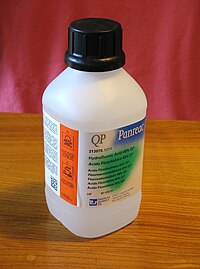Hydrofluoric acid
|
|
|||
|
|
|||
 |
|||
| Names | |||
|---|---|---|---|
| Other names
Fluorhydric acid
Hydronium fluoride |
|||
| Identifiers | |||
|
7664-39-3 |
|||
| 3D model (Jmol) | Interactive image | ||
| ChEBI |
CHEBI:29228 |
||
| ChemSpider |
14214 |
||
| EC Number | 231-634-8 | ||
| RTECS number | MW7875000 | ||
| UNII |
RGL5YE86CZ |
||
|
|||
|
|||
| Properties | |||
| HF | |||
| Molar mass | not applicable (see hydrogen fluoride) |
||
| Appearance | Colorless solution | ||
| Density | 1.15 g/mL (for 48% soln.) | ||
| Melting point | Not applicable (see hydrogen fluoride) |
||
| Boiling point | Not applicable (see hydrogen fluoride) |
||
| Miscible. | |||
| Acidity (pKa) | 3.17 | ||
| Hazards | |||
| Safety data sheet | duPont MSDS | ||
|
EU classification (DSD)
|
|
||
| R-phrases | R26/27/28, R35 | ||
| S-phrases | (S1/2), S7/9, S26, S36/37, S45 | ||
| NFPA 704 | |||
| Flash point | Non-flammable | ||
| Related compounds | |||
|
Other anions
|
Hydrochloric acid Hydrobromic acid Hydroiodic acid |
||
|
Related compounds
|
Hydrogen fluoride | ||
|
Except where otherwise noted, data are given for materials in their standard state (at 25 °C [77 °F], 100 kPa).
|
|||
|
|
|||
| Infobox references | |||
Hydrofluoric acid is a solution of hydrogen fluoride (HF) in water. It is a precursor to almost all fluorine compounds, including pharmaceuticals such as fluoxetine (Prozac), diverse materials such as PTFE (Teflon), and elemental fluorine itself. It is a colourless solution that is highly corrosive, capable of dissolving many materials, especially oxides. Its ability to dissolve glass has been known since the 17th century, even before Carl Wilhelm Scheele prepared it in large quantities in 1771. Because of its high reactivity toward glass and moderate reactivity toward many metals, hydrofluoric acid is usually stored in plastic containers (although PTFE is slightly permeable to it).
Hydrogen fluoride gas is an acute poison that may immediately and permanently damage lungs and the corneas of the eyes. Aqueous hydrofluoric acid is a contact-poison with the potential for deep, initially painless burns and ensuing tissue death. By interfering with body calcium metabolism, the concentrated acid may also cause systemic toxicity and eventual cardiac arrest and fatality, after contact with as little as 160 cm2 (25 square inches) of skin.
Hydrofluoric acid is classified as a weak acid because of its lower dissociation constant compared to the strong acids. It ionizes in aqueous solution in a similar fashion to other common acids:
HF is the only hydrohalic acid that is not considered a strong acid, i.e. it does not fully ionize in dilute aqueous solutions.
When the concentration of HF approaches 100%, the acidity increases dramatically because of homoassociation:
The bifluoride (FHF−) anion is stabilized by the very strong hydrogen–fluorine hydrogen bond.
...
Wikipedia





